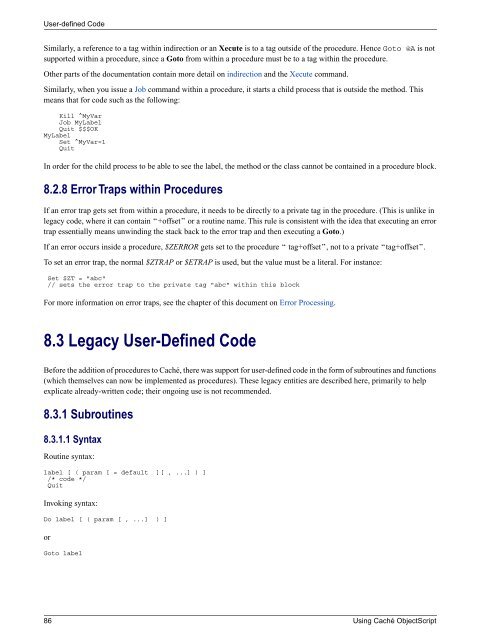Using Caché ObjectScript - InterSystems Documentation
Using Caché ObjectScript - InterSystems Documentation
Using Caché ObjectScript - InterSystems Documentation
Create successful ePaper yourself
Turn your PDF publications into a flip-book with our unique Google optimized e-Paper software.
User-defined Code<br />
Similarly, a reference to a tag within indirection or an Xecute is to a tag outside of the procedure. Hence Goto @A is not<br />
supported within a procedure, since a Goto from within a procedure must be to a tag within the procedure.<br />
Other parts of the documentation contain more detail on indirection and the Xecute command.<br />
Similarly, when you issue a Job command within a procedure, it starts a child process that is outside the method. This<br />
means that for code such as the following:<br />
Kill ^MyVar<br />
Job MyLabel<br />
Quit $$$OK<br />
MyLabel<br />
Set ^MyVar=1<br />
Quit<br />
In order for the child process to be able to see the label, the method or the class cannot be contained in a procedure block.<br />
8.2.8 Error Traps within Procedures<br />
If an error trap gets set from within a procedure, it needs to be directly to a private tag in the procedure. (This is unlike in<br />
legacy code, where it can contain “+offset” or a routine name. This rule is consistent with the idea that executing an error<br />
trap essentially means unwinding the stack back to the error trap and then executing a Goto.)<br />
If an error occurs inside a procedure, $ZERROR gets set to the procedure “ tag+offset”, not to a private “tag+offset”.<br />
To set an error trap, the normal $ZTRAP or $ETRAP is used, but the value must be a literal. For instance:<br />
Set $ZT = "abc"<br />
// sets the error trap to the private tag "abc" within this block<br />
For more information on error traps, see the chapter of this document on Error Processing.<br />
8.3 Legacy User-Defined Code<br />
Before the addition of procedures to <strong>Caché</strong>, there was support for user-defined code in the form of subroutines and functions<br />
(which themselves can now be implemented as procedures). These legacy entities are described here, primarily to help<br />
explicate already-written code; their ongoing use is not recommended.<br />
8.3.1 Subroutines<br />
8.3.1.1 Syntax<br />
Routine syntax:<br />
label [ ( param [ = default ][ , ...] ) ]<br />
/* code */<br />
Quit<br />
Invoking syntax:<br />
Do label [ ( param [ , ...] ) ]<br />
or<br />
Goto label<br />
86 <strong>Using</strong> <strong>Caché</strong> <strong>ObjectScript</strong>

















